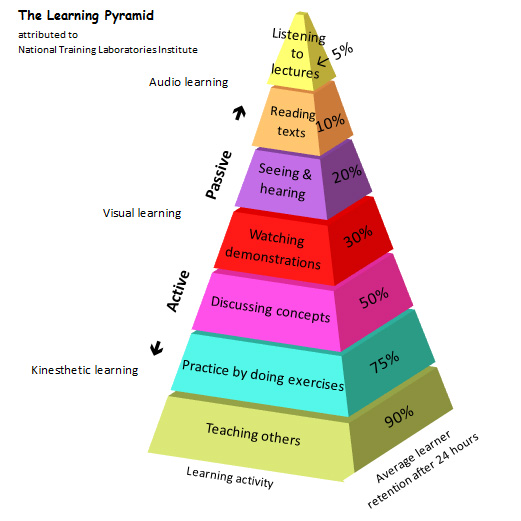 Instructional Strategies
Instructional Strategies
While developing the Learner Plan, you make decisions about what the learner needs to learn. It’s not just “what” they will learn but how the training will take place. The instructional strategies and approaches often have the greatest impact on learner success.
Instructional strategies are the techniques instructors use to deliver training. Instructional strategies should provide effective and productive learning by
- adapting to the learning styles and other needs of each learner
- actively engaging learners in the learning process
- helping learners become independent learners
- supporting learners in reaching their objectives (plan items, sub-goals and goals)
- preparing learners to transition to their goal
The Ministry does not prescribe how training is delivered, but Literacy and Basic Skills (LBS) programming should be responsive to learners’ needs and prepare learners to move along their goal paths.
Lecturing in a classroom setting may be useful for preparing learners for further educational goals like secondary or postsecondary. However, for the most part, you should use a variety of instructional strategies to make learning environments more interactive; to integrate authentic activities and technology into the learning experience; and to support collaborative learning.
Effective LBS instructors understand that all LBS learners have different strengths and needs. The learning content; prior experiences and knowledge of the learner; the learner’s interest and goals; their learning style; and the Task Group Level capabilities of the learner all have a part to play in the decision of what instructional approaches are most suitable. Therefore these practitioners design training based on what they know about the learner. Therefore these practitioners design training based on what they know about the learner.
Instructional Approaches: A Framework for Professional Practice from Saskatchewan Education considers that there are five categories of instructional strategies. The lines between the strategies are not clear-cut and the strategies are not mutually exclusive in any learning relationship.
- Direct Instruction is instructor-directed. It is useful for providing information or developing step-by-step skills. Some examples are lecture, questioning, explicit teaching and demonstrations.
- Indirect Instruction is mainly learner-driven with the teacher becoming a facilitator, supporter and resource person. Because it is learner-driven, it includes a high level of learner involvement in observing, investigating, drawing inferences or forming hypotheses. This strategy takes advantage of learners’ interests and curiosity and encourages learners to generate alternatives or solve problems. Some examples of indirect instruction are problem-solving, case studies, close activities, reading for meaning, reflective discussion and concept mapping.
- Experiential Learning is learner-focused and activity-oriented. Experiential learning requires learners to reflect about the experience and ways to apply it to other contexts. This strategy emphasizes the learning process; not the product. Experiential learning has five phases
- experiencing
- sharing or publishing
- analyzing or processing
- inferring or generalizing
- applying
Some examples of experiential learning are field trips, simulations, experiments, games, role-playing, model building using authentic workplace materials, job placements and surveys.
- Independent Study involves the learners studying on their own under the guidance or supervision of an instructor. This strategy fosters the development of individual student initiative, self-reliance and self-improvement. Independent study may also involve learning in peer partnership or as part of a small group. Examples include essay research and writing, computer-assisted instruction, journals and packaged learning materials.
- Interactive Instruction relies heavily on discussion and sharing. It helps develop social skills and the ability to organize thoughts and develop rational arguments. From the learners it requires observation, listening, interpersonal and intervention skills. This strategy requires the instructor to outline the topic, the amount of discussion time, the composition and size of the groups, and the reporting or sharing techniques. The success of the interactive instruction strategy and its many methods depends on the expertise of the instructor in structuring and developing the group dynamics. Interactive instruction allows for a range of groupings and methods, such as debates, role-playing, simulations, brainstorming, peer learning, discussion and cooperative learning.
The Learning Pyramid
The Learning Pyramid (believed to have been developed by the National Training Laboratories Institute for Applied Behavioral Science) illustrates that different kinds of learning strategies lead to different results in terms of learner retention. The strategies represented at the bottom of the pyramid produce much greater retention rates than those at the top. The diagram also shows that the bottom three strategies involve active learner participation while the four at the top have passive learner involvement. This research clearly illustrates that active participation in the learning process results in more effective uptake and retention of learning.

When designing lessons and activities, it is worth considering where different instructional strategies fall on the Learning Pyramid. By using different strategies, you can accommodate different learning styles and actively engage learners to increase learning.
Questions and Activities for Reflection
- The Learner Plan asks for the learning style of the learner. How does knowing a learner’s learning style affect the instructional strategies you use with the learner?
- Consider the power that teachers have over students’ feelings about themselves and their learning (for better or worse)? How comfortable are you in sharing your power with others–particularly learners?
- Consider the five categories of instructional strategies (direct, indirect, experiential, independent and interactive). Which one do you use most often and why?
- How could you incorporate other strategies into your instruction to better help learners?
- The learning pyramid shows how some learning strategies encourage more active participation from learners. What is one strategy you could use?




